An RF antenna is a critical component in wireless communication systems. It serves as the interface between electromagnetic waves and electronic circuits, enabling the transmission and reception of radio frequency signals. Understanding RF antennas and their various types is essential for optimizing communication systems across industries such as telecommunications, broadcasting, and satellite communication.
What is an RF Antenna?
An RF antenna is a device that transmits and receives electromagnetic waves in the radio frequency (RF) spectrum. It converts electrical signals from transmitters into electromagnetic waves for propagation and captures incoming waves to convert them back into electrical signals. RF antennas are integral to devices like mobile phones, radios, Wi-Fi routers, and satellite systems, facilitating seamless communication over distances.
How Does an RF Antenna Work?
RF antennas operate by creating an oscillating electric current in their elements. This oscillation generates electromagnetic waves that radiate into the surrounding environment. Conversely, when these waves reach the antenna, they induce a corresponding current, which the connected device processes into usable data. The efficiency of this process depends on factors like the antenna design, material, and placement.
Key Features of RF Antennas
Frequency Range
Each RF antenna is designed to operate within a specific frequency range. This range determines the types of signals it can effectively transmit and receive. For instance, antennas used in mobile networks operate within different frequency bands than those used in satellite communication.
Gain and Directivity
Gain measures the ability of an antenna to focus energy in a particular direction, enhancing signal strength. Directivity describes how well an antenna concentrates signals in specific directions. High-gain, highly directive antennas are ideal for applications requiring long-range communication, such as satellite links.
Polarization
Polarization refers to the orientation of the electromagnetic waves radiated by the antenna. Common types include linear, circular, and elliptical polarization. The correct polarization ensures efficient signal transmission and reception, as mismatched polarization can lead to signal loss.
RF Antenna Types
Different applications require specific types of RF antennas. Each design offers unique characteristics suited to particular use cases.
Dipole Antenna
The dipole antenna is among the simplest and most widely used RF antenna types. It consists of two conductive elements that radiate signals in all directions, making it ideal for general-purpose communication. Dipole antennas are commonly used in FM radios, television broadcasting, and some wireless communication systems.
Monopole Antenna
Monopole antennas are similar to dipole antennas but feature a single radiating element. They are often mounted on a conductive surface, which acts as a ground plane. These antennas are compact and efficient, making them popular for applications like mobile devices and automotive communication systems.
Yagi-Uda Antenna
The Yagi-Uda antenna, or Yagi antenna, is a directional antenna designed for long-range communication. It consists of multiple elements, including a driven element, reflectors, and directors. Yagi antennas are widely used in television reception, ham radio, and point-to-point communication.
Patch Antenna
Patch antennas, also known as microstrip antennas, are compact, lightweight, and low-profile. These antennas are commonly used in modern devices like smartphones, GPS systems, and Wi-Fi routers. Patch antennas can be easily integrated into printed circuit boards, making them ideal for applications requiring minimal space.
Parabolic Antenna
Parabolic antennas use a curved reflector to focus RF signals into a narrow beam. This design offers high gain and excellent directivity, making it ideal for satellite communication, radar systems, and astronomy. Parabolic antennas are recognizable by their dish-like structure.
Log-Periodic Antenna
Log-periodic antennas are multi-element, frequency-independent antennas capable of operating across a wide range of frequencies. They are used in applications requiring broadband performance, such as wireless testing, EMC measurements, and broadband communication systems.
Loop Antenna
Loop antennas consist of a closed loop of wire or other conductive material. They are often used in low-frequency applications like AM radio broadcasting and RFID systems. These antennas are compact and provide omnidirectional coverage, making them versatile for various use cases.
Applications of RF Antennas
Telecommunications
In telecommunications, RF antennas are essential for transmitting and receiving signals in mobile networks. They enable seamless communication between devices and base stations, ensuring reliable voice and data transmission.
Broadcasting
Broadcasting systems use RF antennas to transmit television and radio signals over large areas. The choice of antenna type depends on the required coverage area and frequency range.
Satellite Communication
RF antennas are vital for satellite communication, providing the link between ground stations and satellites. Parabolic antennas are commonly used in this field due to their high gain and precision.
Internet of Things (IoT)
IoT devices rely on compact RF antennas to connect to wireless networks. Patch antennas are often integrated into IoT devices, ensuring reliable communication in constrained spaces.
Defense and Aerospace
In defense and aerospace, RF antennas support radar systems, navigation, and secure communication. These applications require high-performance antennas capable of operating in extreme conditions.
Choosing the Right RF Antenna
Selecting the right RF antenna is critical for achieving optimal performance in your communication system. Consider the following factors:
Application Requirements
Identify the specific needs of your application, such as frequency range, gain, and directivity. This ensures that the chosen antenna meets your operational requirements.
Environment
Consider the operating environment, including factors like temperature, humidity, and physical constraints. Outdoor installations may require weather-resistant antennas, while compact antennas are better suited for indoor use.
Compatibility
Ensure that the antenna is compatible with your equipment and complies with industry standards. This prevents signal loss and ensures efficient integration into your system.
Manufacturer Quality
Choose a reputable manufacturer known for producing high-quality RF antennas. Reliable products reduce the risk of performance issues and extend the lifespan of your communication system.
Conclusion
RF antennas are indispensable components in wireless communication systems, enabling seamless signal transmission and reception. From dipole antennas for general use to specialized designs like Yagi-Uda and parabolic antennas, the variety of RF antenna types ensures solutions for diverse applications. By selecting the right antenna and understanding its features, you can optimize your communication systems for efficiency, reliability, and performance.





Leave A Comment